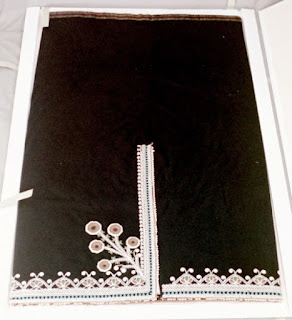by Gwen Spicer
Caroline Parker, was a Tonawanda Seneca and older sister to Levi Parker. They were both friends with Lewis Henry Morgan, a pioneering ethnographer and lawyer from Rochester, New York. It was Morgan who, with the assistance of the Parker family, amassed collections in the mid-nineteenth century of Iroquois artifacts that are now housed at the New York State Museum in Albany, New York; National Museum, Copenhagen, Denmark; and the Rochester Museum & Science Center in Rochester, New York.
 |
| Caroline Parker, ca. 1840. Daguerreotype |
 |
| Caroline Parker wearing articles of traditional Seneca clothing that were sent by Morgan to the NYSM in 1851. Colored lithograph |
Caroline Parker is unusual in the fact that up to recently, she was only known for the clothes that she was pictured wearing and that she had possibly been the creator of these clothes. Morgan's two published reports on the collections made for the New York State Regents and his subsequent League of the Ho-De-No-Sau-Nee or Iroquois included colored lithographs of Caroline and her brother, Levi, dressed in clothing, and of the individual articles of dress, now in the collections of the New York State Museum. The full standing figure image is often used in publications or illustrations in exhibitions of a "typical Iroquois woman". It is fascinating how the clothing has personified not only her, but all Iroquois. Her image, as well as that of her brother, have become the ideal or stereotype of the well dressed Iroquois.
In 1849, Morgan acquired complete Seneca woman's and man's ceremonial costumes of the day, including this skirt (see above image). In the daguerreotype, Caroline Parker is shown wearing the woman's costume, consisting of beaded moccasins, leggings, skirt, overdress, blanket, and handbag. Most, if not all, of which she herself had made.
A note on the images, first between the daguerreotype and the lithograph, the artist did make a few changes. But also when daguerreotypes are created, the image that they produce is a mirror image of the subject. The most notable element is the beaded flower on the skirt. The lithograph, as well as the photograph (both are featured in the images below) of the skirt show it as the object actually exists.
The images below are the plates from Lewis Henry Morgan's Third Regents Report, Chapter 8. The clothing articles are the items that Caroline Parker is wearing in the above images.
 |
| Pl. 6 Over-dress, front |
 |
| Pl. 6a Over-dress, back |
 |
| Pl. 5 Skirt |
 |
| Pl. 4 Female leggings |
 |
| Pl. 2 Moccason, for female (spelling in the report) |
 |
| Pl. 11 Work bag |
What wonderful luck to have these images of the individual artifacts, and how the assemblage would have been worn. A true treasure. This is especially the case as the the vast majority of the artifacts were destroyed by the devastating 1911 fire of the New York State Capital, where all of the collections were on exhibition. Below are the clothing articles that survived, which consists of only the overdress and skirt. Thanks to an IMLS grant in 1998, these and other fragile textiles from the collection were stabilized and rehoused for study.
 |
| Red overdress, NYSM |
 |
| Beaded skirt, NYSM |
The surviving overdress and skirt are considered to have been made by Caroline herself. Her mother, Elizabeth Parker was also known as a needlewoman, so it might be that she also had a part in their construction. However, the RMSC has two beaded textiles, an overdress and table cover, that are attributed solely to Caroline.
Even in the mid-nineteenth century, Iroquois had made adaptions and were influenced by their surroundings. One case in point is the style and cut of the overdress. It has many similarities to the cut of garments worn by the larger New York community during the 1840s. The exception being the beadwork, in particular, which distinguishes it as Native American. (A non-Indian woman, for instance, would have worn lace-trimmed pantalettes instead of bead-trimmed leggings.)
Even in the mid-nineteenth century, Iroquois had made adaptions and were influenced by their surroundings. One case in point is the style and cut of the overdress. It has many similarities to the cut of garments worn by the larger New York community during the 1840s. The exception being the beadwork, in particular, which distinguishes it as Native American. (A non-Indian woman, for instance, would have worn lace-trimmed pantalettes instead of bead-trimmed leggings.)
The New York State Museum has on their website all of their collections: http://collections.nysm.nysed.gov/morgan/. To read more about the skirt www.nysm.nysed.gov/womenshistory/skirt.html.
Rochester Museum & Science Center also has some of their collection online at: http://www3.rmsc.org/museum/exhibits/online/lhm/LHMmain.htm
Many thanks to George Hammell and his assistance with this post.
_____________________________
Gwen Spicer is a textile conservator in private practice. Spicer Art Conservation specializes in textile conservation, object conservation, and the conservation of works on paper. Gwen's innovative treatment and mounting of flags and textiles is unrivaled. To contact her, please visit her website.

No comments:
Post a Comment